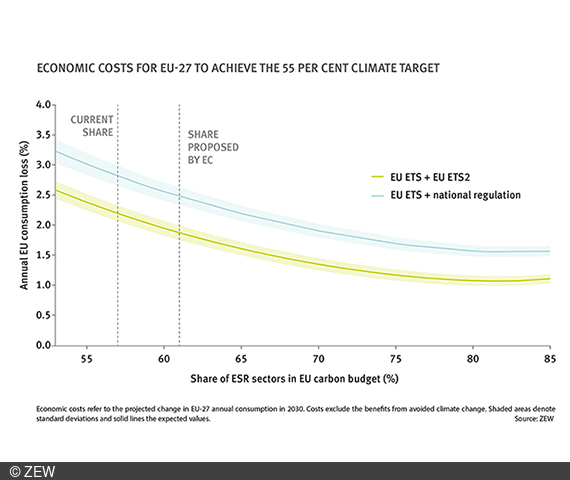Smart Distribution of Emissions Could Save the EU up to 152 Billion Euros
ResearchZEW Environmental Economists Simulate Effects of EU ETS Reform
The reform of the European Emissions Trading Scheme (EU ETS) presented today by the EU Commission will reduce the cost of climate protection in 2030 from 2.8 per cent of EU-wide consumption to 1.9 per cent. The proposal, however, does not exploit the full savings potential of 1.1 per cent. A smart distribution of the CO₂ budget could save the EU up to 152 billion euros in economic costs. The Commissions’ current proposal, on the other hand, reduces climate protection costs by only 81 billion euros, mainly by introducing a second emissions trading system. This is the result of a recent calculation by ZEW Mannheim based on a macroeconomic simulation model.
With its “Fit for 55” package, the EU Commission proposes to reform the European CO₂ markets. Under the reform, the existing EU ETS, which covers the energy sector and energy-intensive industries, is to be supplemented by a second emissions trading system.
“The introduction of a second emissions trading system is an important step in the right direction, because it integrates sectors such as road transport and buildings into emissions trading that have not been covered so far,” says Professor Sebastian Rausch, head of the ZEW Research Department “Environmental and Resource Economics, Environmental Management” and chair holder at Heidelberg University. “Moreover, with this proposal, the EU is significantly reducing the economic costs of achieving its climate targets.”
Climate protection costs can be reduced even further
In 2030, the European Union wants to have its greenhouse gas emissions reduced by 55 per cent compared to the reference year 1990. This will cost the EU around 2.8 per cent of economic output relative to the status quo and create a gap of 247 billion euros that would otherwise be available for private consumption.
“In order to meet the climate goals at the lowest economic cost, emissions should be avoided where it is cheapest,” says environmental economist Rausch.
By optimally distributing the amount of CO₂ that the EU can still emit with a 55 per cent target, the costs could be reduced – from 2.8 per cent of EU-wide consumption (247 billion euros) to 1.1 per cent of consumption (95 billion euros) – as the ZEW researchers found out with their simulation.
“With the new emissions trading system and the current distribution of the CO₂ budget, the EU Commission already manages to lower climate protection costs by 22 per cent,” explains ZEW environmental economist Dr. Jan Abrell and co-author of the study. “If the EU distributes its CO₂ budget wisely, it could even cut costs by up to 61 per cent.”
Since the level of abatement costs varies greatly between sectors, the decision on how the emissions budget is allocated has a direct and significant influence on the distribution of the economic burden between the individual sectors and EU Member States. The buildings and transport sectors would receive a significantly larger emissions budget, while a major part of the ambitious climate targets would have to be realised by avoiding emissions in the electricity sector and energy-intensive industries.
Previous regulation
CO₂ emissions have so far been regulated within two separate systems: the EU Emissions Trading Scheme (EU ETS), which mainly covers emissions from the electricity sector and energy-intensive industries, and the so-called Effort Sharing Regulation (ESR), which defines targets for the transport, buildings, agriculture and industry sectors that fall outside the scope of the EU ETS. In the past, the integration of these sectors into the EU ETS was discussed. With the proposal for an additional trading system, the EU Commission is now taking a different approach.
About the method
With the help of a macroeconomic model, the ZEW environmental economists have simulated in advance which economic costs the proposed EU climate policy will cause and what the optimal market design would look like to keep these as low as possible. In their calculation, the ZEW researchers did not take into account welfare gains resulting from the prevention of climate change, such as the avoidance of health damage and extreme weather events.


